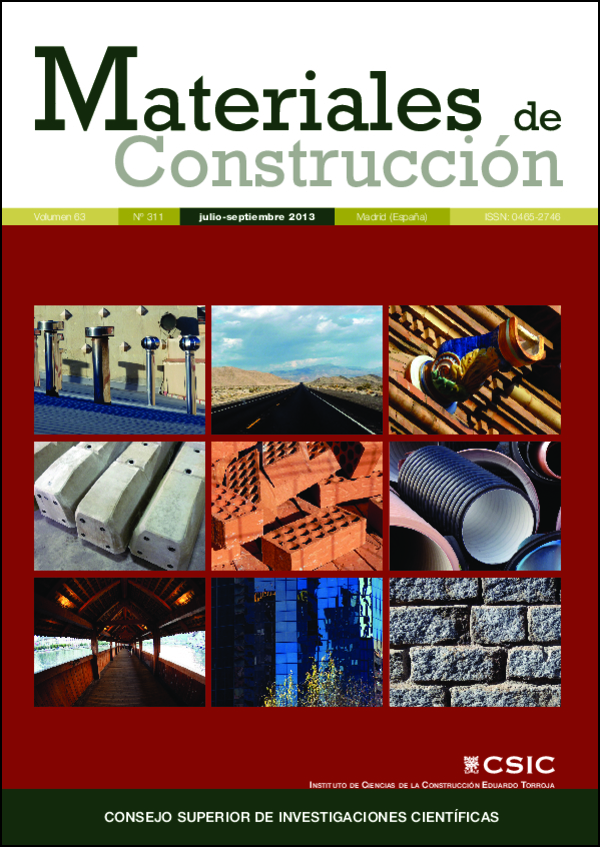La arena como capa intermedia especializada para la mejora del aislamiento acústico entre recintos superpuestos
DOI:
https://doi.org/10.3989/mc.2012.03212Palabras clave:
Forjados, aislamiento acústico, suelos flotantes, arena, rehabilitaciónResumen
En este trabajo se exponen y se analizan los resultados experimentales in situ del aislamiento acústico a ruido aéreo y a ruido de impactos de elementos de separación horizontales, habituales hace años, en los que sobre el forjado se coloca una capa uniforme de arena que sirve de asiento al suelo cerámico. Los resultados de las mediciones acústicas muestran que, cuando en el elemento de separación horizontal entre los recintos hay una capa intermedia de arena, el aislamiento acústico es mejor que el que se obtendría con otros sistemas constructivos de igual masa por unidad de superficie, con el suelo unido rígidamente al forjado. El efecto de la capa de arena colocada entre el forjado y el suelo, en el aislamiento acústico entre los recintos, es el de una capa amortiguadora, que hace que este tipo de suelo pueda considerarse como flotante.
Descargas
Citas
(1) CEN/TR 13548:2004. Rules for design and installation of ceramic tiling.
(2) Manzanal D.G.: Modelo constitutivo basado en la teoría de la plasticidad generalizada con la incorporación de parámetros de estado para arenas saturadas y no saturadas. Tesis Doctoral, E.T.S. de I de Caminos, Canales y Puertos, UPM, (2008).
(3) Schmitt H.; Heene A.: Hochbaukonstruktion, (12th edition), Friedr. Vieweg&Sohn Verlagsgesellschaft mbH, Braunschweig, (1993). http://dx.doi.org/10.1007/978-3-322-85719-4
(4) Beranek, L.: Noise and Vibration Control, McGraw-Hill Inc, (1971).
(5) Ungar, E.E.: Structural Damping. Ver L.I. and Beranek, L., (Eds), Noise and Vibration Control Engineering, Wiley, N York, (2006).
(6) Barkan, D.D.: Dynamics of Bases and Foundations, Ed. McGraw-Hill, (1962).
(7) EN 12354 - 1: 2000, Building Acoustics, Estimation of acoustic performance of buildings from the performance of elements, Part 1: Airborne sound insulation between rooms, Brussels.
(8) EN 12354 - 2: 2000, Building Acoustics, Estimation of acoustic performance of buildings from the performance of elements, Part 2: Impact sound insulation between rooms, Brussels.
(9) (9) EN ISO 140-4, Acoustics- Measurement of sound insulation in buildings and of building elements- Part 4: Field measurements of airborne sound insulation between rooms (ISO 140-4: 1998).
(10) EN ISO 140-7, Acoustics- Measurement of sound insulation in buildings and of building elements- Part 7: Field measurements of impact insulation of floors. (ISO 140-7:1998).
(11) UNE EN ISO 140-14:2005. Acoustics- Measurement of sound insulation in buildings and of building elements- Part 14: Guidelines for special situations in the field.(ISO 140-14:2004).
(12) UNE EN ISO 140-14:2005/AC: 2009. Acoustics- Measurement of sound insulation in buildings and of building elements- Part 14: Guidelines for special situations in the field.(ISO 140-14:2004/Cor 1:2007).
(13) EN ISO 717-1, Acoustics - Rating of sound insulation in buildings and of building elements. Part 1: Airborne sound insulation (ISO 717-1:1996). EN ISO 717-1. Amended 1: Rounding rules related to single number ratings and single number quantities. 2006. (ISO 717-1:1996/AM1:2006).
(14) EN ISO 717-2: 1996, Acoustics - Rating of sound insulation in buildings and of building elements. Part 2: Impact sound insulation (ISO 717-2:1996). EN ISO 717-2: Amended 1:2006 (ISO 717-2:1996/AM 1:2006).
(15) Díaz, C.; Pedrero, A.: "Field measurements of Airborne and Impact Sound Insulation Between Rooms, One on Top of the Other, with Beam and Pot Floor Structures", Acta Acustica United with Acustica, Vol 90 (2004), 982-986.
(16) Heckl, M.; Rathe, E.J.: "Relationship between the transmission loss and the impact noise insulation of floor structures" JASA 1963, 35: 1825-1830.
(17) Cremer, L.; Heckl, M.: Structure Borne Sound, 2nd edition, Berlin, Springer Verlag, (1988).
(18) Gerretsen E.: "Calculation of airborne and sound insulation between dwellings", Applied Acoustics .1985, 19: 245-264.http://dx.doi.org/10.1016/0003-682X(86)90001-0
Descargas
Publicado
Cómo citar
Número
Sección
Licencia
Derechos de autor 2013 Consejo Superior de Investigaciones Científicas (CSIC)

Esta obra está bajo una licencia internacional Creative Commons Atribución 4.0.
© CSIC. Los originales publicados en las ediciones impresa y electrónica de esta Revista son propiedad del Consejo Superior de Investigaciones Científicas, siendo necesario citar la procedencia en cualquier reproducción parcial o total.
Salvo indicación contraria, todos los contenidos de la edición electrónica se distribuyen bajo una licencia de uso y distribución “Creative Commons Reconocimiento 4.0 Internacional ” (CC BY 4.0). Consulte la versión informativa y el texto legal de la licencia. Esta circunstancia ha de hacerse constar expresamente de esta forma cuando sea necesario.
No se autoriza el depósito en repositorios, páginas web personales o similares de cualquier otra versión distinta a la publicada por el editor.
















